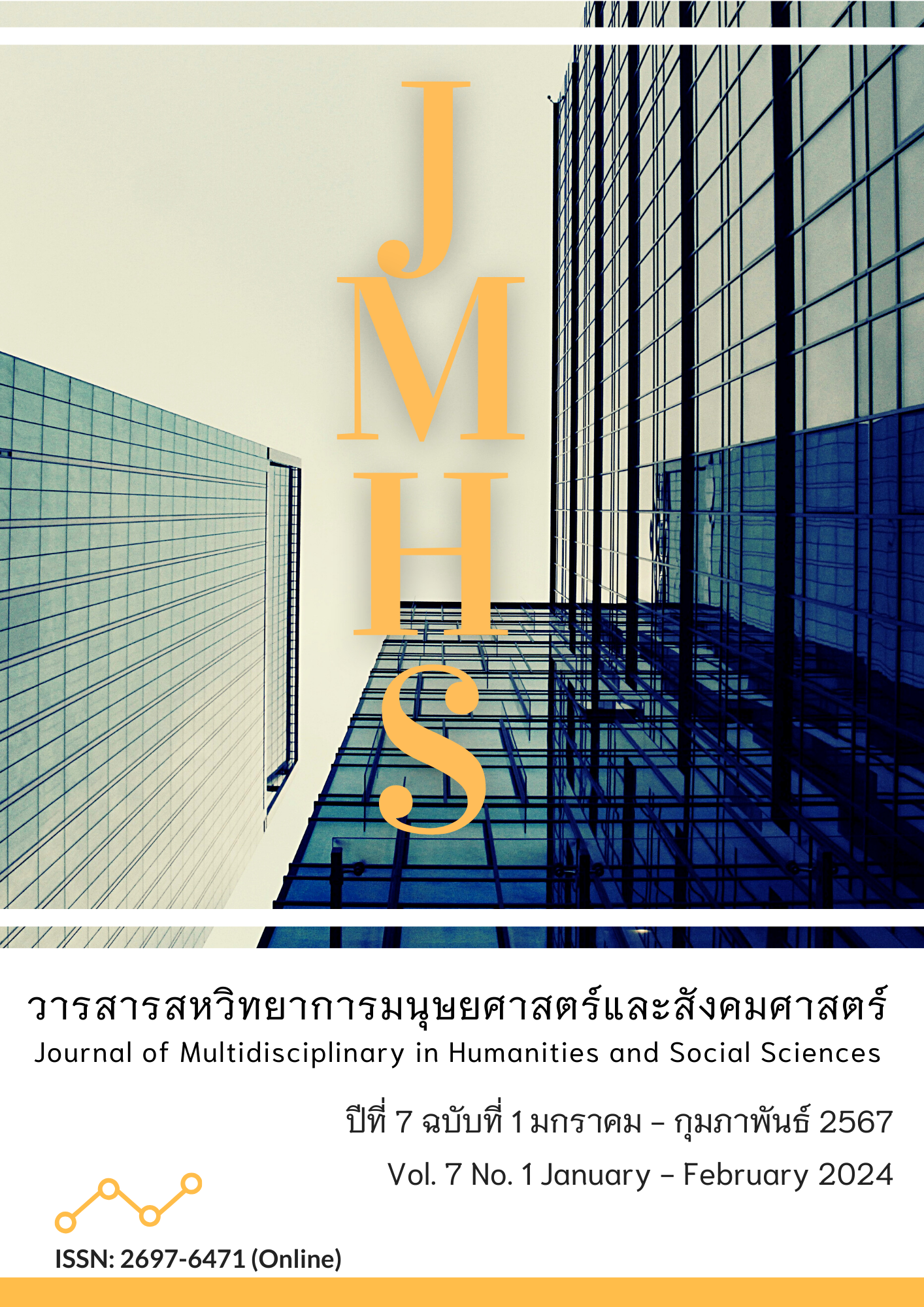Causal Factors Influencing Social Media Use Behavior in Internal Communications of the Royal Thai Air Force Officer
Main Article Content
Abstract
The article aimed to study 1. develop and validate the consistency of a causal relationship model social media use behavior in internal communications of the royal Thai air force officer; and 2. study causal factors influencing social media use behavior in internal communications of the royal Thai air force office. This study was quantitative research. The tools used in the research was online questionnaires. The sample was the royal Thai air force officer who usage social media internal communications of the royal Thai air force of 295 people by simple sampling. There are 2 types of tools used in the research: 1) online questionnaires and 2) The statistics used in data analysis were frequency, percentage, confirmatory factor analysis and structural equation model.
The results of the research showed that 1. the causal relationship model consistency of 6 components are 1) performance expectancy, 2) effort expectancy, 3) social influences, 4) facilitating conditions, 5) intention, and 6) use behavior and the model was consistent with the empirical data to a great extent. The statistic shows CMIN = 141.071, df = 82, P Value = .000, CMIN/df = 1.72, GFI = 0.95, AGFI = 0.90, SRMR = 0.04, RMSEA = 0.05. The final was a predicted coefficient of 0.62, and 2. Conditions for facilities It has the most direct influence on social media use behaviors in internal communications of the royal Thai air force officer. Which can be used as a guideline for planning strategies Arrangement of necessary equipment for use It creates effective behavior in using social media in internal communications of the royal Thai air force officer.
Article Details

This work is licensed under a Creative Commons Attribution-NonCommercial-NoDerivatives 4.0 International License.
Views and opinions appearing in the Journal it is the responsibility of the author of the article, and does not constitute the view and responsibility of the editorial team.
References
กรมเทคโนโลยีสารสนเทศและการสื่อสารทหารอากาศ. (2562). แผนแม่บทเทคโนโลยีสารสนเทศและการสื่อสารกองทัพอากาศ พ.ศ 2563 – 2570. สืบค้นเมื่อ 11 มีนาคม 2566, จาก https://dict.rtaf.mi.th/index.php/2017-02-01-02-07-02/2017-02-01-02-09-19/ downloadbook-plan/244-2017-03-02-03-37-24
กรรณิการ์ คงทอง และ รุจิภาส โพธิ์ทองแสงอรุณ. (2563). ความตั้งใจเชิงพฤติกรรมในการใช้เทคโนโลยีของกลุ่มเจเนอเรชั่นเบบี้บูมเมอร์และเจเนอเรชั่นเอ็กซ์. วารสารวิชาการสถาบันเทคโนโลยีแห่งสุวรรณภูมิ, 6(2), 43-57. สืบค้นจาก https://bu-mba.rmutk.ac.th/wp-content/uploads/2019/12/kannika_2018.pdf
กัลยา วานิชย์บัญชา. (2559). การวิเคราะห์สถิติ: สถิติสำหรับการบริหารและวิจัย. (พิมพ์ครั้งที่ 16). กรุงเทพฯ: ภาควิชาสถิติ คณะพาณิชยศาสตร์และการบัญชี จุฬาลงกรณ์มหาวิทยาลัย.
คลังปัญญามหาวิทยาลัยเทคโนโลยีราชมงคลธัญบุรี. (2554). แนวทางการใช้สื่อการเรียนรู้และสื่อสังคมออนไลน์ (Social Media) เพื่อการสื่อสารภายในองค์กร. สืบค้นเมื่อ 18 มกราคม 2566, จาก http://www.repository.rmutt.ac.th/dspace/handle/123456789/291
รัฐชินี สุทธิผลไพบูลย์ และ สมชาย เล็กเจริญ. (2563). ปัจจัยเชิงสาเหตุที่มีผลต่อพฤติกรรมการใช้งานเว็บไซต์ RTAF.LIVE ในการรับรู้ข้อมูลข่าวสารของข้าราชการกองทัพอากาศไทย. วารสารรังสิตสารสนเทศ, 27(2), 6-25. สืบค้นจาก https://rilj.rsu.ac.th/journal/56/article/265
วิริยาภรณ์ เตชะกฤตธีรพงศ์ และ ศรีสมรัก อินทุจันทร์ยง. (2559). ปัจจัยการยอมรับการใช้งานเทคโนโลยีการทำงนร่วมกันของบุคลากรในองค์การ. วารสารบริหารธุรกิจ, 39(152), 30-44. สืบค้นจาก http://www.jba.tbs.tu.ac.th/index.php?page=Article-List&sub=1&txt=548
ธัญญลักษณ์ พลวัน, สุพรรษา กุลแก้ว และ ณัฐสิทธิ์ เกิดศรี. (2554). การศึกษาพฤติกรรมการใช้เทคโนโลยี และปัจจัยที่มีผลต่อการยอมรับเทคโนโลยี OR Code ของกลุ่มประชากรในเขตกรุงเทพมหานคร. วิศวกรรมสาร มหาวิทยาลัยเกษตรศาสตร์, 27(88), 29-40. สืบค้นจาก https://ph01.tci-thaijo.org/index.php/kuengj/article/view/79572
ศิริลักษณ์ โรจนกิจอำนวย. (2562). การยอมรับการใช้โมบายแบงก์กิ้งของธนาคารพาณิชย์ไทยอย่างต่อเนื่อง. วารสารวิชาการบริหารธุรกิจ, 8(2), 10-21. สืบค้นจาก https://so04.tci-thaijo.org/index.php/KAB/article/view/244954
สุมามาลย์ ปานคำ และ เบญจพร กาทอง. (2565). ปัจจัยเชิงสาเหตุที่มีอิทธิพลต่อพฤติกรรมการใช้แอปพลิเคชัน S.M.A.R.T SOLDIERS ในการรับรู้ข่าวสารของข้าราชการกองทัพบก. วารสารสหวิทยาการมนุษยศาสตร์และสังคมศาสตร์, 5(3), 9-11. สืบค้นจาก https://so04.tci-thaijo.org/index.php/jmhs1_s/article/download/257802/176024
สุวิกา แสงพันธุ์ตา และ สุมามาลย์ ปานคำ. (2561). รูปแบบความสัมพันธ์เชิงสาเหตุพฤติกรรมการใช้โซเชียลมีเดียในการสื่อสารภายในองค์กรของบุคลากรกระทรวงแรงงาน. วารสาร มจร พุทธปัญญาปริทรรศน์, 4(1), 83-98. สืบค้นจาก http://www.journalgrad.ssru.ac.th/index.php/miniconference/article/view/1442
สุอัมพร ปานทรัพย์ และ ดัชกรณ์ ตันเจริญ. (2561). การประเมินการใช้งานแอปพลิเคชัน 7-Eleven TH บนพื้นฐานของทฤษฎีการยอมรับและการใช้เทคโนโลยี. วารสารวิทยาการและเทคโนโลยีสารสนเทศ, 10(1), 85-97. สืบค้นจาก https://ph02.tci-thaijo.org/index.php/JIST/article /download/240863/163977/831292
สำนักงานพัฒนาธุรกรรมทางอิเล็กทรอนิกส์. (2564). รายงานผลการสำรวจพฤติกรรมผู้ใช้อินเทอร์เน็ตในประเทศไทย ปี 2564. สืบค้นเมื่อ 10 มกราคม 2566, จาก https://www.etda.or.th/th/pr-news/ETDA-released-IUB-2021.aspx
สำนักงานพัฒนาธุรกรรมทางอิเล็กทรอนิกส์. (2565, 21 สิงหาคม). รายงานผลการสำรวจพฤติกรรมผู้ใช้อินเทอร์เน็ตอินเทอร์เน็ตในประเทศไทย ปี 2565. สืบค้นเมื่อ 11 มกราคม 2566, จาก https://www.etda.or.th/getattachment/78750426-4a58-4c36-85d3-d1c11c3db1f3/IUB-65-Final.pdf.aspx
สำนักงานสถิติแห่งชาติ. (2564). สำรวจการมีการใช้เทคโนโลยีสารสนเทศและการสื่อสารในครัวเรือน พ.ศ. 2564 (ไตรมาส 2). สืบค้นเมื่อ 11 มกราคม 2566, จาก http://www.nso.go.th/sites/2014en/Survey/ICT/Survey%20In%20Household/2021/fullreport_64_q2.pdf
อธิชัย ชื่นอารมณ์ และ ธัญนันท์ บุญอยู่. (2563). โมเดลสมการโครงสร้างปัจจัยด้านการรับรู้ที่มีผลต่อพฤติกรรมการใช้ระบบบริหารจัดการคิวอาร์โค้ดของเจ้าหน้าที่โรงพยาบาลเอกชนแห่งหนึ่งในเขตธนบุรี. วารสารรังสิตสารสนเทศ, 26(1), 6-21. สืบค้นจาก https://www.sau.ac.th /graduate/PDF_Research/ResearchAJ/Research-%20(36).pdf
อภัสนันท์ สระน้อย และ สุมามาลย์ ปานคำ. (2564). ปัจจัยเชิงสาเหตุที่มีผลต่อพฤติกรรมการใช้งานโชเชียลมีเดียในการสื่อสารภายในองค์กรของบุคลากรภายใน บริษัท ท่าอากาศยานไทย จำกัด (มหาชน). วารสารสหวิทยาการมนุษยศาสตร์และสังคมศาสตร์, 5(3), 17-11.
Hair, J. F., Black, W. C., Babin, B. J., & Anderson, R. E. (2010). Multivariate Data Analysis. (7th ed.). New York: Pearson.
Hair, J. F., Hult, G. T. M., Ringle, C. M., & Sarstedt, M. (2014). A Primer on Partial Least Squares Structural Equation Modeling (PLS-SEM). Thousand Oaks, CA: Sage.
Hoelter, J. W. (1983). The Effects of Role Evaluation and Commitment on Identity Salience. Social Psychology Quarterly, 46(2), 140–147. https://doi.org/10.2307/3033850
Hu, L.T., & Bentler, P. M. (1999). Cutoff Criteria for Fit Indexes in Covariance Structure Analysis: Conventional Criteria Versus New Alternatives. Structural Equation Modeling, 6(1), 1–55. https://doi.org/10.1080/10705519909540118
Joreskog, K. G., & Sorbom, D. (1984). Advances in Factor Analysis and Structural Equation Models. Lanham: Rowman & Littlefield.
Kline, R. B. (2011). Principles and Practices of Structural Equation Modeling. (3rd ed.). New York: The Guilford Press.
Muneer, M. A. M. (2021). Using the UTAUT Model to Understand Students’ Usage of E-learning Systems in Developing Countries. Education and Information Technologies, 26, 7205-7224. Retrieved from https://link.springer.com/article/10.1007/s10639-021-10573-5
Schreiber, J. B., Stage, F. K., King, J., Nora, A., & Barlow, E. A. (2006). Reporting Structural Equation Modeling and Confirmatory Factor Analysis Results: A Review. The Journal of Educational Research, 99(6), 323–337. https://doi.org/10.3200/JOER.99.6.323-338
Schumacker, R. E., & Lomax, R. G. (2004). A Beginner's Guide to Structural Equation Modeling. (2nd ed.). New Jersey: Lawrence Erlbaum Associates.
Schumacker, R. E., & Lomax, R. G. (2010). A Beginner’s Guide to Structural Equation Modeling. (3ed ed.). Oxfordshire: Routledge.
Thompson, B. (2004). Exploratory and Confirmatory Factor Analysis: Understanding Concepts and Applications. Washington, D. C.: American Psychological Association.
Ullman, M. T. (2001). The Declarative/Procedural Model of Lexicon and Grammar. Journal of Psycholinguistic Research, 30(1), 37–69. https://doi.org/10.1023/A:1005204207369
We are Social. (2022). Digital 2022: Another Year of Bumper Growth. Retrieved from https://wearesocial.com/uk/blog/2022/01/digital-2022-another-year-of-bumper-growth-2/


